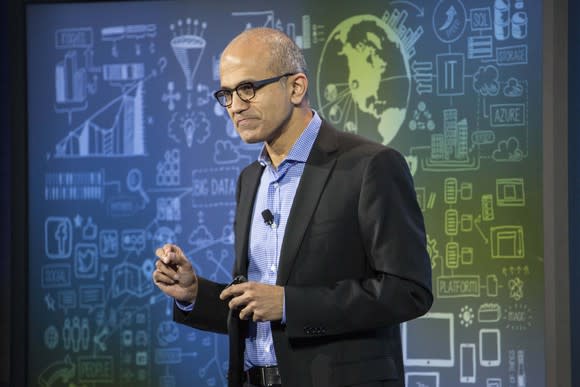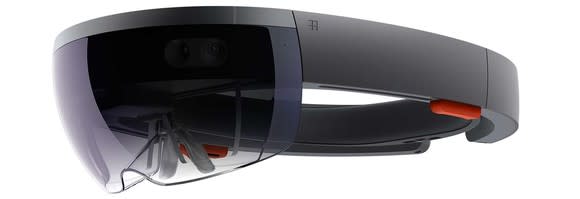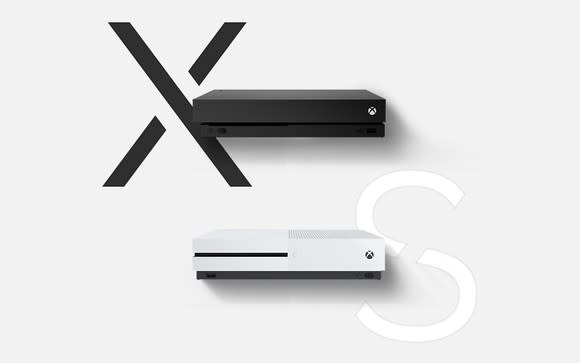Where Will Microsoft Corporation Be in 10 Years?
Shares of Microsoft (NASDAQ: MSFT) have more than tripled over the past five years, stunning many investors who believed that the tech giant's heyday had long passed. Much of Microsoft's growth spurt can be attributed to Satya Nadella, who succeeded Steve Ballmer as the company's CEO in 2014.
But can Microsoft keep growing over the next 10 years? Let's take a look back at the company's previous turnaround and where it could be headed.

Microsoft CEO Satya Nadella. Image source: Microsoft.
How did Nadella fix Microsoft?
When Nadella took the helm, he launched a "mobile first, cloud first" strategy to reduce Microsoft's dependence on sales of Windows and Office licenses through expansion of its mobile apps and cloud services. Nadella also aimed to change Microsoft's smartphone strategy, which had mainly consisted of launching Windows Phones (supported by its acquisition of Nokia's smartphone unit).
To make that happen, Microsoft offered free Windows 10 upgrades to consumers, discontinued the Windows Phone business, focused on launching Microsoft apps for iOS and Android instead of building its own hardware and OS, and ushered legacy Office users toward Office 365 subscriptions. It also expanded its lineup of Surface devices.
Last year Nadella stated that the company had reached "a billion" Windows users worldwide. Microsoft also tethered Xbox One consoles to the Windows ecosystem with universal apps and let gamers stream Xbox games to Windows PCs. The HoloLens "mixed reality" headset, which it launched for developers in 2016, further expanded the Windows ecosystem into the augmented and virtual reality markets.

Microsoft's HoloLens. Image source: Microsoft.
Microsoft also invested heavily in the expansion of Azure, which is now the second-largest cloud infrastructure platform in the world after Amazon's (NASDAQ: AMZN) AWS (Amazon Web Services). In 2015, Nadella declared that Microsoft would generate $20 billion in annual cloud revenues by mid-2018, but it surpassed that target in late 2017. All those moves initially weighed down Microsoft's earnings, but strengthened its revenue growth and brightened the company's long-term outlook.
Where will Microsoft head over the next decade?
Over the next 10 years, Microsoft's commercial cloud revenues -- which mostly come from Office 365, Azure, and Dynamics CRM -- should keep growing and pivot its business away from sales of individual software licenses. The overall SaaS (software as a service) market, which includes Office 365 and Dynamics, could grow from $72.2 billion this year to $113.1 billion by 2021, according to Gartner. During the same period, the combined IaaS/PaaS [infrastructure and platform as a service] markets -- which Azure and AWS currently lead -- could grow from $46.2 billion to $90.7 billion.
Microsoft can also leverage its dominance of enterprise PC operating systems to cross-sell additional services and hold Amazon at bay, and expand its ecosystem into adjacent enterprise markets with platforms like LinkedIn and Skype.
Microsoft will also continue launching more of its core mobile apps on iOS and Android in the years to come. It will likely expand Bing (search) and Cortana (virtual assistant) across both mobile platforms -- as well as other smart devices like smart speakers and smart appliances -- to keep pace with Amazon's Alexa and Alphabet's Google Assistant.
Microsoft is leaving the smartphone hardware market behind, but it will likely keep expanding the Surface family with new convertibles, notebooks, all-in-one PCs, and other devices. Those devices will generate extra revenue for Microsoft, but the main focus will be on spurring design and form factor innovations across the Windows PC market -- which could keep Apple on its toes.

The Xbox One X and Xbox One S. Image source: Microsoft.
On the gaming front, Microsoft is expected to launch a next-generation Xbox within the next few years to counter Sony's (NYSE: SNE) next-generation PlayStation. We should also see the company's multi-platform Project xCloud go toe-to-toe against Sony's PS Now and Google's Project Stream. Microsoft could also acquire more game developers to complement its previous purchases of game makers like Mojang, Playground, and Ninja Theory.
When Microsoft finally launches the commercial version of the HoloLens, it could finally lure more developers to the AR and VR space. That move could kick start the global AR/VR market, which Research and Markets believes could be worth $94.4 billion by 2023.
It's not just about Windows and Office anymore
Under Steve Ballmer, Microsoft relied too heavily on its Windows and Office cash cows, neglected the cloud market, and arrived far too late to the smartphone market. Nadella reversed many of those mistakes, and reinvigorated Microsoft with bold new strategies. If all goes well, Microsoft could enter a new heyday over the next decade as those new initiatives pay off.
More From The Motley Fool
John Mackey, CEO of Whole Foods Market, an Amazon subsidiary, is a member of The Motley Fool's board of directors. Suzanne Frey, an executive at Alphabet, is a member of The Motley Fool's board of directors. Teresa Kersten is an employee of LinkedIn and is a member of The Motley Fool's board of directors. LinkedIn is owned by Microsoft. Leo Sun owns shares of Amazon and Apple. The Motley Fool owns shares of and recommends Alphabet (A shares), Alphabet (C shares), Amazon, and Apple. The Motley Fool has the following options: long January 2020 $150 calls on Apple and short January 2020 $155 calls on Apple. The Motley Fool recommends Gartner. The Motley Fool has a disclosure policy.
